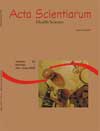<b>Validação de métodos analíticos na quantificação de comprimidos de Captopril - comparação de metodologias para um programa de garantia de qualidade</b> - DOI: 10.4025/actascihealthsci.v26i2.1590
Resumen
Atualmente, quando todos os caminhos levam à busca da qualidade total, torna-se indispensável conhecer perfeitamente cada fase de um processo produtivo. Neste caso, a validação é a ferramenta adequada para garantir a confiabilidade de instalação de um processo produtivo, de equipamento e, inclusive, da metodologia analítica. Dessa forma, o presente trabalho teve por objetivo analisar os principais aspectos da validação de métodos analíticos na quantificação do captopril. Foi realizada a validação e a comparação dos seguintes métodos: titulométrico por óxido-redução, espectrofotométrico por Folin-Ciocalteau e cromatográfico por cromatografia líquida de alta eficiência - CLAE. Os atributos de exatidão, precisão, linearidade, especificidade e robustez foram estudados para cada metodologia. Os resultados obtidos demonstraram que o método cromatográfico foi o mais adequado para as análises dos comprimidos de Captopril 25 mg, enquanto que os métodos espectrofotométrico e titulométrico demonstraram valores que satisfazem os critérios de aceitação, porém, com maior variabilidade e menor sensibilidade.Descargas
DECLARAÇÃO DE ORIGINALIDADE E DIREITOS AUTORAIS
Declaro que o presente artigo é original, não tendo sido submetido à publicação em qualquer outro periódico nacional ou internacional, quer seja em parte ou em sua totalidade.
Os direitos autorais pertencem exclusivamente aos autores. Os direitos de licenciamento utilizados pelo periódico é a licença Creative Commons Attribution 4.0 (CC BY 4.0): são permitidos o acompartilhamento (cópia e distribuição do material em qualqer meio ou formato) e adaptação (remix, transformação e criação de material a partir do conteúdo assim licenciado para quaisquer fins, inclusive comerciais.
Recomenda-se a leitura desse link para maiores informações sobre o tema: fornecimento de créditos e referências de forma correta, entre outros detalhes cruciais para uso adequado do material licenciado.























5.png)







